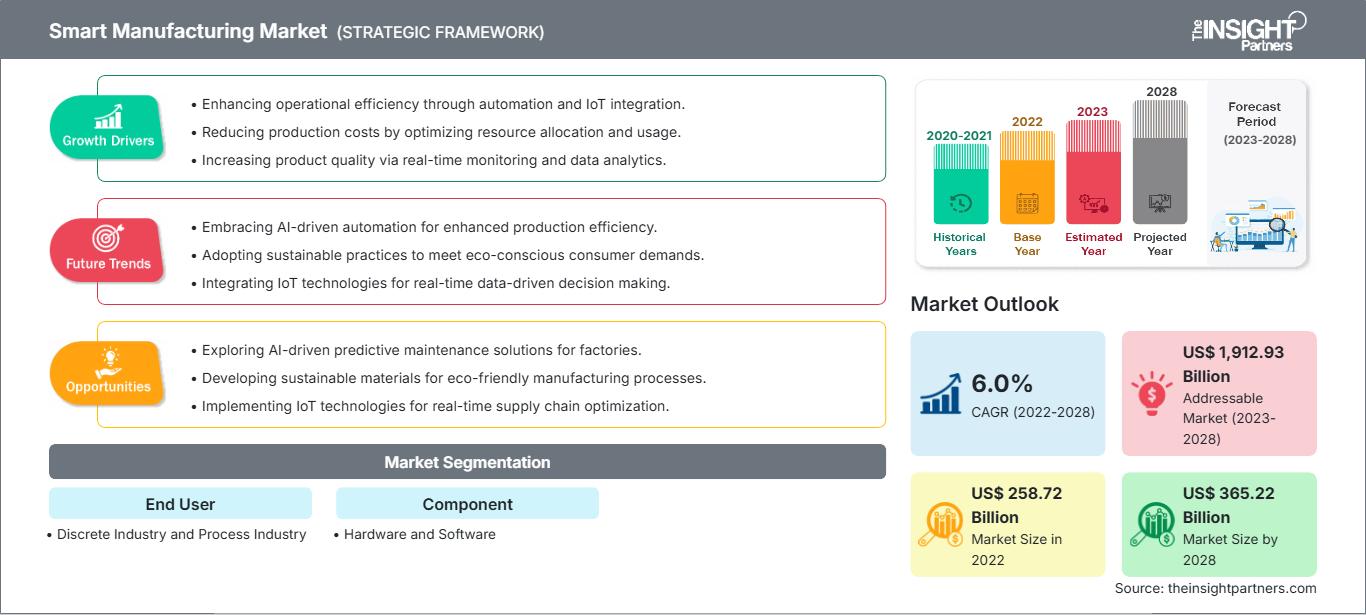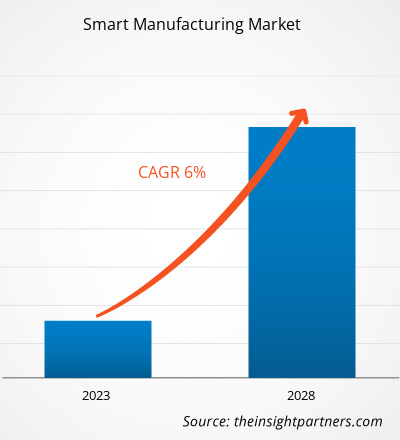[研究报告] 预计智能制造市场规模将从 2022 年的 2496.28 亿美元增长到 2028 年的 3652.2 亿美元;预计 2022 年至 2028 年的复合年增长率为 6.0%。
分析师观点:
近年来,智能制造市场经历了显著的增长和创新。智能制造,又称工业 4.0 或第四次工业革命,是指将人工智能 (AI)、物联网 (IoT)、云计算、大数据分析和机器人等先进技术融入制造业。智能制造解决方案通过提高效率、生产力和灵活性,彻底改变了传统的制造运营方式。这些技术可以实现实时监控、自动化、预测性维护和智能决策,从而改善质量控制、减少停机时间、优化供应链并节省成本。智能制造市场涵盖汽车、航空航天、电子、制药、食品饮料以及消费品等多个领域。尤其是汽车行业,已经采用智能制造实践来简化生产流程、增强产品定制化,并满足日益增长的电动汽车和自动驾驶需求。除了提高运营效率外,智能制造还注重可持续性和环境影响。通过优化资源利用率、减少浪费和实施节能措施,制造商可以最大限度地减少碳足迹,为可持续发展做出贡献。预计未来几年全球智能制造市场将持续增长。推动这一增长的因素包括对自动化需求的不断增长、对实时数据分析和预测性维护的需求,以及物联网设备和云平台的日益普及。此外,5G 连接和边缘计算等技术进步预计将加速智能制造解决方案的普及。
市场概览:
“智能制造”是指一种全球性行业战略,该战略基于开发创新的集成生产技术和解决方案,这些技术和解决方案已在全球范围内得到日益广泛的应用。为了实现生产运营的最佳可扩展控制,有必要在制造工厂中引入通过互联网将机器互联的系统。智能制造领域的一些知名技术包括工业物联网 (IIoT)、制造业区块链、机器人技术、ERP 系统、预防性维护、增强现实和虚拟现实、数据分析以及自动化包装。因此,工业企业持续投资并开发应用这些技术的新方法,以提高生产效率。此外,企业也在加大力度提升市场产品。由美国工业组织、技术供应商、研发机构和大学组成的“智能制造领导联盟”正在构建下一代智能制造平台和智能工厂互联互通系统。
自定义此报告以满足您的要求
您将免费获得任何报告的定制,包括本报告的部分内容,或国家级分析、Excel 数据包,以及为初创企业和大学提供超值优惠和折扣
智能制造市场: 战略洞察

- 获取本报告的主要市场趋势。这个免费样本将包括数据分析,从市场趋势到估计和预测。
您将免费获得任何报告的定制,包括本报告的部分内容,或国家级分析、Excel 数据包,以及为初创企业和大学提供超值优惠和折扣
智能制造市场: 战略洞察

- 获取本报告的主要市场趋势。这个免费样本将包括数据分析,从市场趋势到估计和预测。
市场驱动因素:
工业机器人采用率的提高推动智能制造市场的增长
随着越来越多的行业需要实现自动化,工业机器人的部署也随之增加。由于电子行业的不断扩张和制造业劳动力成本的不断上升,工业机器人为市场的增长做出了贡献。这可能会导致在研究期间对工业机器人的需求增加,从而支持智能制造市场的增长。由于对绿色技术和能源效率的日益关注,企业可以通过提供耗能更少、更节能的智能制造来增加市场份额并吸引新客户。预计在预测期内,对绿色系统的投资将出现惊人的增长。工业机器人越来越多地应用于制造业,以提高产品效率、生产率和质量。它们可以高精度、快速和准确地执行重复性任务,有助于减少错误并提高产品质量。机器人也可以完成一些对人类来说危险或难以完成的任务,例如在不安全的环境中工作或移动相当大的物体。随着工业机器人的日益普及,机器学习、人工智能和物联网 (IoT) 等新技术也正在开发中,这些技术使机器人更加智能、高效。这些技术正在助力打造新一代智能机器人,使其能够与人类和其他机器人协同完成复杂的制造任务。工业机器人的日益普及也推动了智能制造市场的扩张,因为它增加了对自动化解决方案、数据分析和其他用于优化制造流程和提高产品质量的技术的需求。
细分分析:
根据最终用户,智能制造市场细分为离散行业和流程行业。离散行业在 2020 年占据了最大的市场份额,预计在预测期内将实现最高的复合年增长率。由于汽车、航空航天和国防等离散制造流程对自动化和数字化的需求不断增长,智能制造市场中的离散细分市场占据了最大份额。这些行业采用智能制造技术有助于提高效率、降低成本并加强质量控制。这导致对智能制造解决方案的需求增加,从而推动了离散细分市场的增长。此外,对工业 4.0 和工业物联网 (IIoT) 的日益关注预计将进一步推动智能制造市场离散细分市场的增长。
区域分析:
2022 年亚太智能制造市场价值为 787.6 亿美元,预计到 2028 年将达到 1.1153 亿美元;预计在预测期内,其复合年增长率将达到 5.5%。亚太地区占据了最大的市场份额。在预测期内,该地区预计也将经历最快的增长。中国和印度等发展中国家正在努力实现智能制造的全面自动化,因为这些市场蕴藏着巨大的未开发潜力。由于多种因素,亚太地区已成为智能制造市场的主导者。该地区占据主导地位的主要原因之一是政府和私营机构在开发先进制造技术方面投入了大量资金。中国、日本和韩国等国家大力投资开发机器人、人工智能和物联网 (IoT) 等技术,以改进制造流程并提高生产力。除了政府和私营部门的投资外,亚太地区还拥有大量熟练的劳动力,这对于开发和部署先进制造技术至关重要。该地区拥有大量高技能的工程师、科学家和技术人员,能够开发和实施制造业的新技术。亚太地区也是许多世界领先制造公司的所在地,尤其是在电子和汽车领域。这些公司在开发先进制造技术方面投入巨资,以提高效率、降低成本和提高生产力。因此,该地区正在成为制造业的创新中心,许多新技术正在开发和测试中,然后在全球范围内推广。
日益增长的定制产品需求也推动了亚太地区智能制造市场的发展。随着消费者的要求越来越高,并期望产品能够满足他们的需求,制造商正在转向3D打印和机器学习等先进技术,以快速高效地打造定制产品。亚太地区拥有众多全球领先的3D打印公司,因此该地区具备良好的条件来利用这一趋势。最后,亚太地区也受益于制造业对云计算和大数据分析日益增长的认可。这些技术被用于收集和分析来自各种来源(包括传感器、机器和其他设备)的海量数据,以确定可用于改进制造流程和产品质量的模式和趋势。该地区拥有庞大且不断发展的云计算基础设施,这有助于推动这些技术在制造业的应用。
关键参与者分析:
智能制造市场分析包括横河电机株式会社、思科系统公司、霍尼韦尔国际公司、3D 系统公司、大福株式会社、通用电气、IBM 公司、甲骨文公司、西门子股份公司和施耐德电气等参与者。在智能制造领域,思科系统公司和西门子股份公司凭借其提供的多元化产品组合位居前两位。
智能制造市场区域洞察
The Insight Partners 的分析师已详尽阐述了预测期内影响智能制造市场的区域趋势和因素。本节还讨论了北美、欧洲、亚太地区、中东和非洲以及南美和中美洲的智能制造市场细分和地域分布。
智能制造市场报告范围
| 报告属性 | 细节 |
|---|---|
| 市场规模 2022 | US$ 258.72 Billion |
| 市场规模 2028 | US$ 365.22 Billion |
| 全球复合年增长率 (2022 - 2028) | 6.0% |
| 历史数据 | 2020-2021 |
| 预测期 | 2023-2028 |
| 涵盖的领域 |
By 最终用户
|
| 覆盖地区和国家 | 北美
|
| 市场领导者和主要公司简介 |
|
智能制造市场参与者密度:了解其对业务动态的影响
智能制造市场正在快速增长,这得益于终端用户需求的不断增长,而这些需求又源于消费者偏好的不断变化、技术进步以及对产品优势的认知度不断提升等因素。随着需求的增长,企业正在扩展其产品线,不断创新以满足消费者需求,并抓住新兴趋势,从而进一步推动市场增长。

- 获取 智能制造市场 主要参与者概述
最新动态:
智能制造市场中的企业广泛采用并购等非有机和有机战略。以下列出了一些近期的关键市场动态:
- 2022年10月 - ABB宣布Accelleron Industries AG(一家关键任务应用高功率涡轮增压器的先驱)已获准在苏黎世瑞士证券交易所(SIX Swiss Exchange)上市,股票代码为“ACLN”。此举旨在完成Accelleron从ABB的分拆。
- 2022年7月 - ABB与SKF签署谅解备忘录(MoU),探讨在制造流程自动化领域开展合作的可能性。通过此次合作,两家公司将确定并评估旨在提升制造能力并支持客户提高生产效率的解决方案。
- 历史分析(2 年)、基准年、预测(7 年)及复合年增长率
- PEST和SWOT分析
- 市场规模、价值/数量 - 全球、区域、国家
- 行业和竞争格局
- Excel 数据集
近期报告
客户评价
购买理由
- 明智的决策
- 了解市场动态
- 竞争分析
- 客户洞察
- 市场预测
- 风险规避
- 战略规划
- 投资论证
- 识别新兴市场
- 优化营销策略
- 提升运营效率
- 顺应监管趋势




















 获取免费样品 - 智能制造市场
获取免费样品 - 智能制造市场